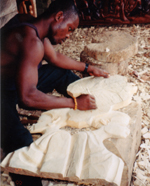Jan 25, 2016
INDIGENOUS APPRENTICESHIP SYSTEMS
INDIGENOUS APPRENTICESHIP SYSTEMS
Ghana's indigenous apprenticeship system has been an important part of its informal economy, particularly for its role as a complimentary means of skills transfer and the development of the nation's human capital required for the overall national development. The main strengths of traditional apprenticeship are its practical orientation, its self-regulation, and self-financing. Its flexible and non-formal nature accommodates individuals who lack the educational requirements for formal training. However, this type of training often is of long duration and low pay, and lacks certification.
In Ghana there is a highly developed apprenticeship system where young men and women undertake sector-specific private training, which yields skills used primarily in the informal sector. Traditionally, children are mandated to learn from the orthodox de-schooling system to acquire permanent learning experience. The aim of this education is to inculcate the norms, values and culture of the group to the young. This is considered a complete socialization of the child. Other facets of traditional curriculum on practical skills adopt learning by observation, trial and error which requires cognitive mapping of processing and producing information as knowledge.
Informal, formal and accidental learning processes were utilized in the transmission of knowledge. Formal learning includes the hierarchically structured school system that runs from primary school through the university and organized school-like programs created in business for technical and professional training. Accidental learning happens when in everyday activities an individual learns something that he or she had not intended or expected.
Informal learning includes the lifelong processes whereby individuals acquired attitudes, values, skills and knowledge from daily experiences and the educative influences and resources in his or her environment, from family and neighbors, from work and play, from the market place, and various rites of passage and ceremonies. Through informal processes the Akan child, for example, was taught (1) to know the history of the society through abakosem and mpaninsem; (2) to show respect (anidee›); (3) to know the names of objects in the child's natural and social environment; (4) to know how to count (akontaa); and, (5) to know various aspects of moral and ethical values. Besides the family's socialization processes, public storytelling (anansesem), games, songs, drama, riddles (abrome), quizzes (ebisaa), and proverbs (abebusem) formed very important informal means of educating the child.
Apprenticeship Systems
The indigenous apprenticeship systems (known among the Akan as adwumasua, ntetee› or esom) constituted a very important means for transmitting formal and institutionalized or specialized knowledge. Various initiation ceremonies and rites were performed at major points in the institutionalized learning process. These rites of passage served to accept formally the prospective trainee into the appropriate trade, to mark major transitions from one grade to another during training, and to graduate and accept formally one into the professional practice. The major goal of these institutionalized learning settings was to impart, rather than hide, knowledge and skills to accredited learners. The curricula for the specialized knowledge transmitted varied as illustrated with the examples of learning statecraft to be a king, learning to be a priest, and leaning to be a wood carver.
Becoming a king - Learning statecraft
Among the Akan, for example, the king-elect undergoes formal education (ahemfie adesua) during a period of six-week confinement. The curriculum of the ahemfie adesua comprises, among other things, the history and organization of the kingdom, court etiquette, drum poetry, dancing, and palace structure and administration. Learning one's history is very important to the Akan. This is because if one does not know what went on before one came into the world (past history) and what is happening at the time one lives, but away from one (current history), one will not know the world and will be ignorant of the world and mankind.
Priesthood
The curriculum of the priesthood training included divination; diagnosis of diseases; prescription of cures; identification of herbs and roots and their medicinal qualities; moral lessons on respect of elders and the general public, equity of care, frugality, obedience, industry, cooperation, and chastity and abstinence; and songs and dance. Divination was based on the manipulation, usually by the casting of cowrie shells (serewa or sedee›), pebbles, or some other divining devices and the recitation of specific oral texts and codes associated with particular configurations of the divining objects. Each configuration resulting from the casting of the divining devices is associated with a body of text and this text is recited after the tossing of the divining devices. An experienced priest was able to diagnose a disease and fit it into one or more of the following principal categories of illness and disease: honam yaree› (illness of the body - e.g., rheumatism, piles, boils); nsane yaree (infectious illness - e.g., yaws, measles, chicken pox)); abusua yaree (illness of the matrilineal group); mogya yaree (illness of the blood, that is, genetical disease); and sunsum yare (spiritually-caused illness).
Wood Carving Apprenticeship
Apprenticeship training in wood carving progresses in phases. In accord with these processes, most apprentices start with an introductory phase during which the novice is taught and made to do menial jobs such as cleaning the workshop or running errands. The next phase consists of getting to know all tools of the trade and, as appropriate, the materials (types of woods and their availability), the ingredients and the spare parts. Meanwhile, the apprentice is expected to observe and learn about the work. The master occasionally demonstrates a particular operation or directs an apprentice whose trials usually end in an error. Gradually the apprentice is introduced to more complex tasks and given increased responsibility such as supervising other apprentices, dealing directly with customers, and from time to time, looking after the shop in the absence of the master. Thus, skills, knowledge and attitudes are transmitted through observation, imitation and on-the-job experience.

